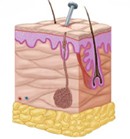Your patient is a 44-year-old male with a history of diabetes. He is lying on the living room floor, unresponsive to all stimuli. He has a respiratory rate of 12 breaths per minute, heart rate of 112 beats per minute, and is pale and sweaty. Which of the following should you do to treat this patient?
A) Apply oral glucose solution to a tongue depressor and insert it between the patient's cheek and gums.
B) Place the patient in the recovery position, administer oxygen, and monitor his airway status.
C) Place the patient in the recovery position to protect the airway and place oral glucose solution under the patient's tongue.
D) Encourage the patient's family to administer his insulin.
B
You might also like to view...
Describe three variations of petrissage technique and examples of how they may be applied in a session
What will be an ideal response?
Which of the following is a term used to describe the spreading of cancer cells from a primary site of origin to distant sites?
a. Active transport b. Pinocytosis c. Depolarization d. Metastasis
Non-smoking spouses of smokers have how much of a greater risk of developing lung cancer than a spouse of a non-smoker?
A.15% B. 30% C. 50% D. 70%
 What type of wound is pictured here?
What type of wound is pictured here?
A. Incision B. Puncture C. Laceration D. Contusion E. Abrasion